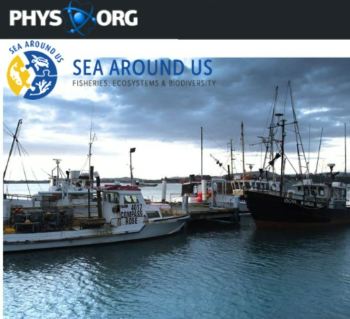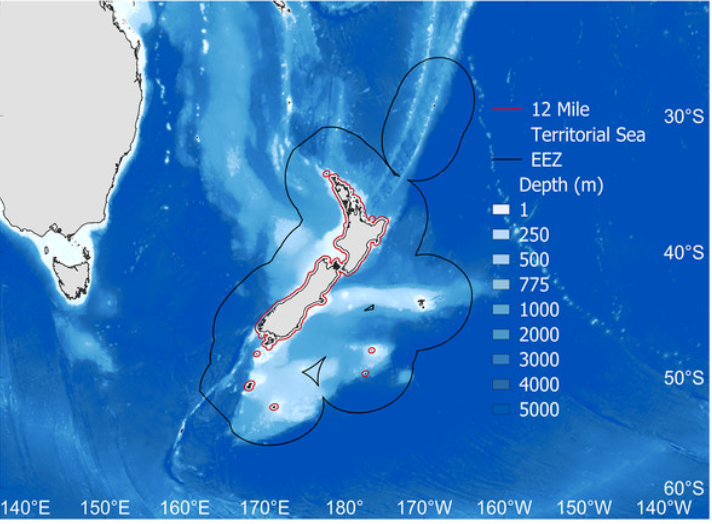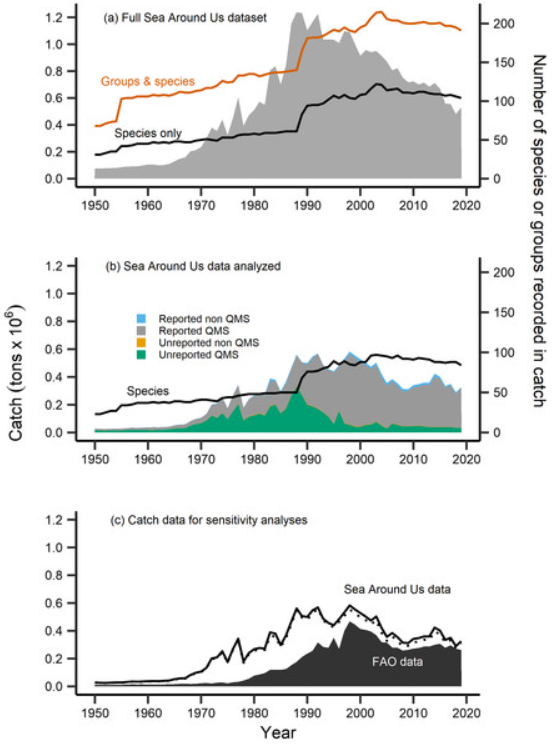|

New Zealand fishing boat. Credit: QFSE Media, Wikimedia Commons /Phys.org
Overfishing and climate change impacts on New Zealand's fish populations were hidden—until now
 NEW ZEALAND
NEW ZEALAND
Monday, September 25, 2023, 01:00 (GMT + 9)
Pelagic-oceanic fish commonly caught in warmer waters, such as skipjack tuna and blue mackerel, have been increasing in New Zealand's waters since the 1950s, while cold-water species such as southern bluefin tuna display strong reductions in overall catch from the 1970s onwards, new research has found.

Fisheries catch data were extracted for the New Zealand Exclusive Economic Zone (EEZ, black line). Also shown is the 12 nautical mile Territorial Sea border (red), as well as depth (m). Map source credit: GADM.
In a paper published in the journal PeerJ, an international team of researchers shows that, despite ocean water temperature around the island country modestly increasing by 0.04°C per decade from 1950–2019, the presence of warmer-climate species is a clear indicator of the impacts of climate change on marine life.
 "The problem is that these trends had been 'hidden' or masked because, as technology progressed, fishing fleets have been able to continue catching cold water species. These, however, are not the same species as before but rather deep-sea fish—where the water is cooler," Charles Lavin, lead author of the study and a doctoral fellow at Nord University, explained. "As gear development promoted further expansion into deeper and cooler waters, snoek or barracouta, southern blue whiting and hoki started dominating New Zealand's fisheries catches." "The problem is that these trends had been 'hidden' or masked because, as technology progressed, fishing fleets have been able to continue catching cold water species. These, however, are not the same species as before but rather deep-sea fish—where the water is cooler," Charles Lavin, lead author of the study and a doctoral fellow at Nord University, explained. "As gear development promoted further expansion into deeper and cooler waters, snoek or barracouta, southern blue whiting and hoki started dominating New Zealand's fisheries catches."
To reach these conclusions, Lavin and his co-authors applied the Mean Temperature of the Catch (MTC) to New Zealand's catch data for the past 60+ years. This indicator measures the average temperature preference of exploited fish species weighted by their annual catch for a given area. If it goes up—as it did in this case –, it means that the proportion of species associated with warmer waters has risen.
"Given the growing ability of fleets to fish deeper and further offshore, we estimated the MTC not for the entire Exclusive Economic Zone altogether but rather by habitat classification and fishing gear. This allowed us to group species based on similar environmental conditions and habitats," Lavin said.

Fisheries catch (solid areas, tons × 106, left axis) including (A) the full catch dataset extracted from the Sea Around Us database, (B) the restricted Sea Around Us catch dataset that was analyzed in the present study, and (C) catch data analyzed in sensitivity analyses. The full dataset (A) included catch information at the species level (black line, right axis) and also for groups at higher taxonomic resolution (red line, right axis), while the catch data analyzed (B) was restricted to the species level (black line, right axis), composed of catch from species both included and not included in New Zealand’s Quota Management System (QMS), from reported and non-reported sources (i.e., reconstructed). (C) FAO catch data of n = 42 species analyzed in sensitivity analyses (black area, left axis), compared to the analyzed Sea Around Us catch data (n = 102, solid black line, left axis), and the further reduced Sea Around Us catch data (n = 42, dashed line, left axis) also contained in sensitivity analyses.
The expansion of fishing operations hasn't only occurred in terms of depth but also in terms of width. The study notes that starting in the late 1960s, New Zealand's fishing operations began moving further offshore as they were given economic incentives including subsidies for new vessels and an expanded list of exploitable species.
 "This expansion also helped mask the fact that they were fishing down the marine food web as nearshore stocks were depleted," said Daniel Pauly, co-author of the study and the principal investigator of the Sea Around Us initiative at the University of British Columbia. "Once the largest species, often of the highest trophic levels and long-lived, were depleted near the coast, fishing pressure shifted to smaller, shorter-lived species of lower trophic levels and also further offshore." "This expansion also helped mask the fact that they were fishing down the marine food web as nearshore stocks were depleted," said Daniel Pauly, co-author of the study and the principal investigator of the Sea Around Us initiative at the University of British Columbia. "Once the largest species, often of the highest trophic levels and long-lived, were depleted near the coast, fishing pressure shifted to smaller, shorter-lived species of lower trophic levels and also further offshore."
By going farther, fisheries were able to tap into previously untapped stocks of big fish higher in the food chain, at least for a while.
.png)
New technology allows fleets to double fishing capacity—and deplete fish stocks faster. Photo: Phys.org
By combining two indexes that help determine the trophic level of the species dominating the catch, the researchers noted that from 1950 to 2000, high trophic level species were caught but thereafter, low trophic level fish became more common.
 "Using these indicators, we were able to identify that from 1950 to about 1965, fisheries were targeting a couple of fish stock assemblages along the New Zealand shelf. As the fishing industry developed, high trophic level fish stocks became fully exploited and the catch started showing signs of fishing down," said Mark Costello, co-author of the paper and a researcher at Nord University. "This incentivized the expansion, in 1969, into a previously unexploited stock assemblage located offshore." "Using these indicators, we were able to identify that from 1950 to about 1965, fisheries were targeting a couple of fish stock assemblages along the New Zealand shelf. As the fishing industry developed, high trophic level fish stocks became fully exploited and the catch started showing signs of fishing down," said Mark Costello, co-author of the paper and a researcher at Nord University. "This incentivized the expansion, in 1969, into a previously unexploited stock assemblage located offshore."
So far, this offshore stock assemblage has allowed New Zealand's fisheries to maintain big fish catches, but this is due to the dominance of hoki or blue grenadier, which is commercially important but also a deeper-water species.
"Our results highlight the pervasiveness of fishing down the food web in New Zealand fisheries and how this trend can be obscured by technological developments that enabled fisheries' geographic expansion," Costello said. "When designing policies, management must consider the compound effects of fishing pressure and ocean-warming-induced changes in fish populations. This means that fishing effort should probably be reduced on stocks that are overexploited and/or shifting their geographic distribution away from areas where they have been historically fished."
More information: Lavin CP, Pauly D, Dimarchopoulou D, Liang C, Costello MJ. 2023. Fishery catch is affected by geographic expansion, fishing down food webs and climate change in Aotearoa, New Zealand. PeerJ(2023). DOI: 10.7717/peerj.16070
Journal information: Peer
Provided by Sea Around Us
[email protected]
www.seafood.media
|



